The Rogue River is a prime contender in the all-around camp knife category. Here’s why you should take a look at one.
by Leon Pantenburg
L.T. Wright supplied this knife for field testing. I was not paid to write this. The company has no sponsorship relationship with Survivalcommonsense.com, and had no input into this review.
Talk about branding.
As soon as I heard about the L.T. Wright Rogue River I knew I had to have one. I live in Oregon, and the Rogue is about 100 miles from where I live. Several years ago, my wife and I did a week-long camping trip along the Rogue. It was summer, and I was already eyeing the river with the idea of doing some fall steelhead fishing along it.
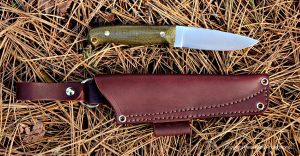
The L.T. Wright Rouge River is designed to be a do-it-all camp knife.
If the knife lived up to its name, it would have to be as rugged as that whitewater river, and as tough and enduring as the people who float it.
The Rogue River was designed, according to the L.T. Wright website, to be “…small enough to be unobtrusive, yet large enough to meet the demands of outdoor life.”
That’s a tall order for any knife.
Right out of the box, the Rogue River grabbed my attention. This is my fifth L.T.Wright, and the Rouge has the craftsmanship I expect from the company. The blade was hair-popping sharp, and finish and craftsmanship is superb.
Here are the specs:
- Total Length: 8 2/3″ (220mm)
- Blade Length: 4″ (104mm)
- Blade Thickness: 1/8″ (3.07mm)
- Blade-Steel: A-2 Steel
- Other Features: Ground Spine, Lanyard Hole, High-Quality Leather Sheath
I field test knives by using them for their intended purposes. In this case, the Rogue would be expected to perform all the tasks a camp knife would do, as well as “other duties as assigned.”
This can be anything from cleaning fish, to spreading peanut butter on crackers, to cutting rope to slicing a summer sausage. The knife handled all those jobs quite well.
The good stuff:
Toughness: A user knife has to be tough. For me, that means a quality steel blade bonded to a bulletproof handle. My Rogue has A2 steel and a micarta handle.
For me, this is the near-ideal combination for a tough knife. A plus was the green handle – a nod to my Irish ancestry!
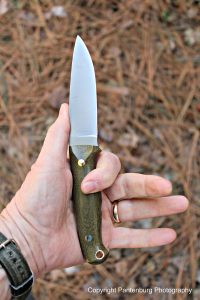
The handle is a good fit for my glove-size large hands.
Handle: The design of a handle is more important than the material in it. If a handle doesn’t fit YOUR hand, it doesn’t matter how ergonomic it is for anyone else. I wear size-large gloves, and my right palm measures four inches across. The Rogue handle fits me just fine.
It is also large enough in diameter for me to get a good solid grip on it. (This is consistent through all the L.T. Wrights I own. Thank you, L.T., for making a handle for those of us with working man hands!)
Micarta, contrary to reason, gets more tacky when wet. This is important in a handle that may get bloody, slimy from fish goo and wet from slicing tomatoes.
Something else to consider when buying a knife – can I use it safely wearing gloves? In extreme cold, you don’t want to remove your gloves to make feather sticks or do other survival-related cutting tasks.
Point: The blade has a drop point, with the blade tip located about three-quarters up the blade from the cutting edge. This is a sturdy, useful configuration. It works well on a hunting knife, while still serving efficiently for overall use.
Blade length is just about perfect for an all-around knife. Four inches is a good choice for a knife that will be called upon to do just about anything. From the practical point of view, four inches is the minimum needed to scrape the bottom of a peanut butter jar.
Blade thickness is 1/8-inch, which is a good compromise, and OK with me. For my tastes, it could go thinner and that would make it a better slicer. Thicker would be too much and turn the Rogue into a less-versatile pry bar.
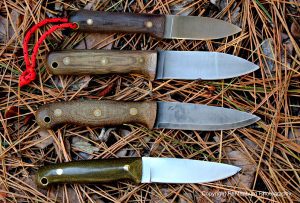
Strong family resemblance; From top: Next Gen, Genesis, GNS and the Rogue River. All show some honest use.
Blade grind is another personal preference. The rouge comes with a flat grind and mini-bevel. It works very well for slicing and everything else. But – personal preference – I wish it was a full convex grind. I also prefer chocolate over vanilla, dogs over cats, and steaks well done.
Spine grind is something you don’t think much about until you need one. The Rogue spine is ground at 90 degrees, like an ice skate, which makes it usable to process tinder and shred pitchwood or scrape ferro rods for firemaking. Learn how to use the spine and you’ll save the primary edge.
Sheath: The Rogue comes with a sturdy leather sheath that protects the edge and the user. I particularly like the option of making the sheath into a dangler. IMHO, a dangler sheath is safer and more comfortable to carry than just about any other version. The Rogue sheath also has the option of being worn directly on a belt, if that is your preference.
Lanyard hole: Any knife I could be using in deep snow must have a lanyard hole. This is where the bright paracord or long streamer goes. Drop a knife in several feet of snow, and you’ve lost it. There are a lot of reasons to put a lanyard on a knife, and if you don’t have some way to attach it, you’re out of luck.
Made in the USA: All L.T. Wright knives are made in Wintersville, Ohio, by American craftspeople. Call the shop (like I did), and a pleasant person with a Midwestern accent answers. The company and workers pay taxes and support their community. Support American small business!
On a personal note, I appreciate it when American-made knives are named after American places. Somebody make an Okefenokee, Yellowstone, Teton or Atchafalaya!
And the bottom line is:
The Rogue River is a solid performer with no particular bells and whistles. If you’re looking for a well-built tool designed to work, the Rouge is for you. It can do just about everything well, and excels in some areas. You will like the knife, and use it a lot.
Please click here to check out and subscribe to the SurvivalCommonSense.com YouTube channel, and here to subscribe to our weekly email update – thanks!

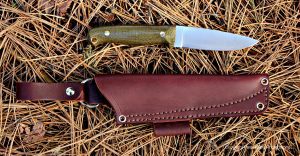


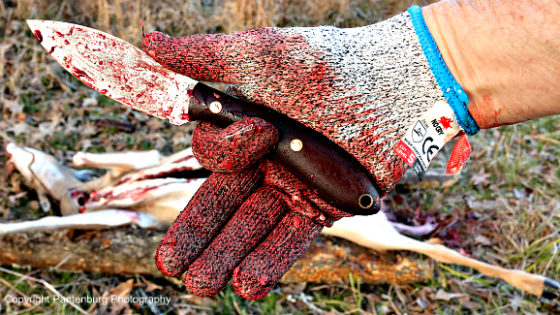
Leave a Reply